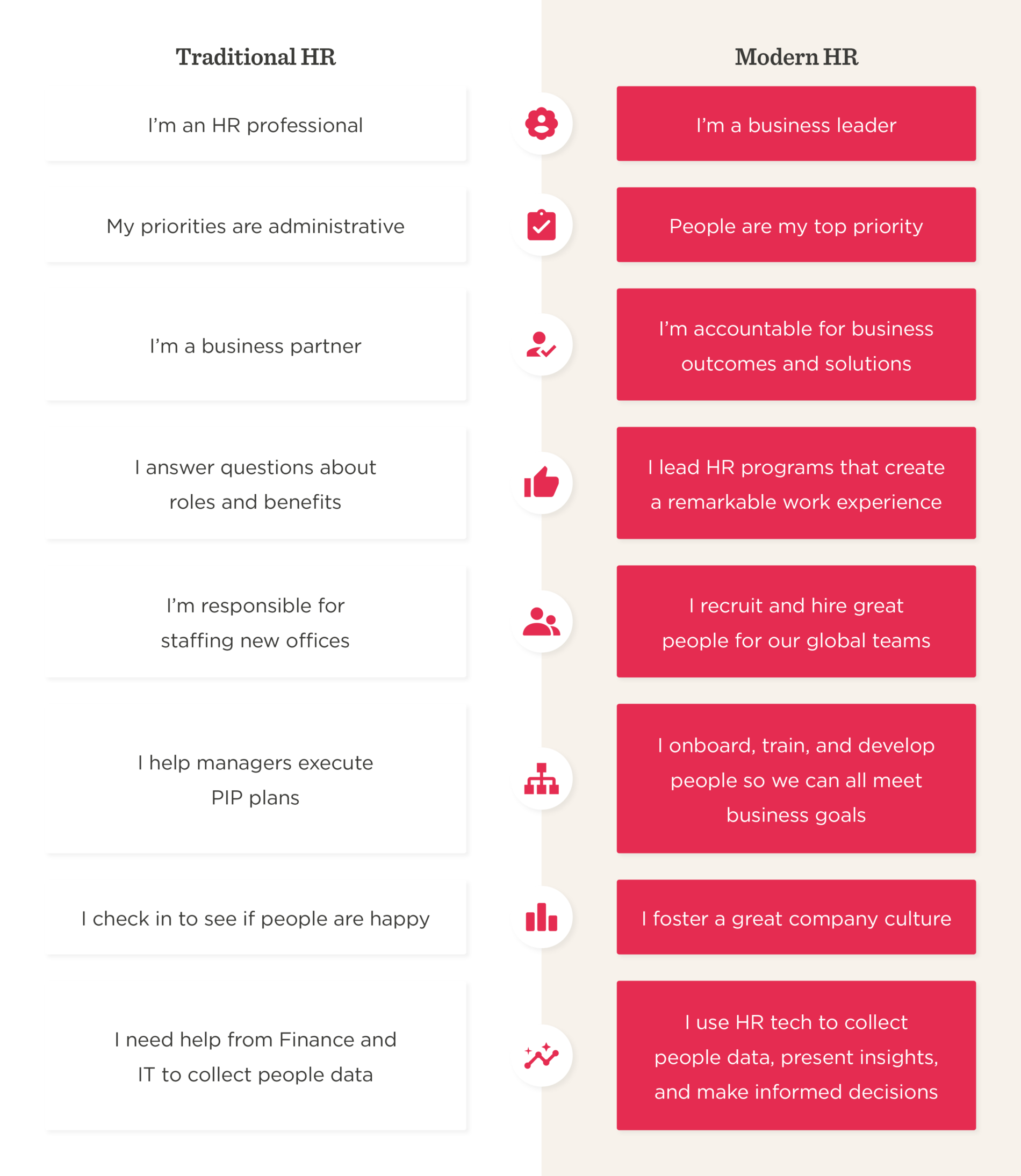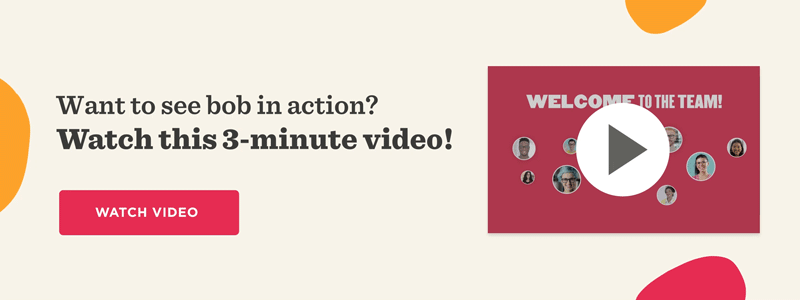Introduction
HR is about so much more than payroll and processes. Automation and HR tech can take care of that now—leaving HR leaders the time and energy to deal with more advanced needs, like employee experience and developing retention strategies.
Traditionally, HR professionals’ responsibilities have revolved around payroll and policing policy. The pandemic increased organizations’ reliance on HR, and HR leaders are now integral stakeholders in the business. In this guide, we cover the four key ways HR leaders need to develop their skills to truly shine as an HR Director, Chief People Officer, or HR Lead.
The evolution of the modern HR leader

The challenge: adapting to the HR leadership skillset
Until recently, the HR function was a primarily administrative role focused on managing payroll and compliance. However, the function has shifted dramatically in recent years, and HR leaders’ role has evolved with it. To excel as an HR leader, you need to master a new set of skills.
In an interview with HiBob, Josh Bersin identifies the four attributes that separate HR people from HR leaders: mastering the basics, embracing data, staying agile and innovative, and understanding business strategy.
Read on to learn how to develop these skills.

1. Master the basics
Modern companies struggle with the war for talent, the Great Resignation, and the changing expectations of today’s candidate- and worker-driven market. DDI’s HR Leadership Insights Report shows that the changes in today’s workforce require HR leaders to expand the scope of their roles and expertise. The knowledge HR leaders bring to the executive table is critical to overcoming these challenges.
Organizations have always depended on HR leaders’ expertise and knowledge of labor laws, benefits, compensation, medical and family leave, and other policies. Today’s most successful HR leaders also have a deep understanding of organizational psychology, employee engagement, DE&I best practices, and more. This knowledge helps create safe and healthy company cultures and increases productivity, retention, and performance.
To brush up on or improve your knowledge of HR fundamentals, you can use these three methods:
Subscribe
Trade publications perform a range of functions for the engaged HR manager. Global publications and websites like Harvard Business Review and Bersin by Deloitte offer critical insight into trends and developments, offering the latest thinking and research. This is a great way to stay connected to studies and academic theory as they apply to the modern workplace. In addition, respected publications like this can bolster your proposals for new strategic directions to C-level stakeholders.
Top HR leaders also keep informed of regional trends and policy changes with more locally relevant publications that will help you stay up to date with local labor laws and community changes. Industry-specific publications will help you plan recruitment, engagement, and retention strategies that fit your demographic.
Attend events (virtual and in-person)
Connecting with colleagues in different organizations is another excellent way to stay abreast of the essential basics. You’re probably already promoting peer-to-peer learning opportunities within your organization, so doing the same with your counterparts in other organizations can be a key way to keep your finger on the pulse.
You’ll learn about tactics and strategies, get help solving knotty problems, receive recommendations for vendors and products, and focus on new and emerging areas of thought. Keep an eye out for location networking groups or companies offering opportunities, and make the most of them whenever you can.
Look out for:
- After work networking evenings
- Panels
- Round tables
- Conferences
- Webinars
Upskill with courses and seminars
Continuous learning is a hallmark of great HR leaders, so look out for degrees, short courses, diplomas, lectures, and online learning opportunities to help fill in any gaps in your (and your team’s) knowledge. For example, employment law, tech skills, occupational health and safety, and organizational psychology are all important pieces of the HR puzzle.

2. Embrace data
In today’s remote and hybrid workplaces, lean operations are essential to surviving and thriving. However, organizations are more complex than ever before. We need to develop agile responses to changes: silos being broken down and work modes shifting from traditional full-time permanent employees to contractors, remote, and outsourced workers. In this environment, having the right tools to analyze and interpret people data is the only way to make meaningful change and achieve success.
Reliance on SaaS technologies has skyrocketed as more and more organizations adopt remote and hybrid work structures. This increased dependence on tech has led to greater collaboration between HR and IT. Organizations must integrate people processes that collect and analyze data to drive strategic business decisions and improve overall performance.
With a strong foundation in digital tools and capture mechanisms, here are just some of the ways organizations can use data and HR tech:
Automate and improve hiring and onboarding
Reducing time-to-hire is a key metric for HR professionals. Understanding where the bottlenecks are in your hiring process will help you make smart changes and improve your recruitment process. Automation can also help with onboarding, increasing retention, and fostering loyalty and employee engagement from the start.
Measure productivity at the individual, team, and organizational levels
Setting up clear project goals and targets, as well as measuring them, means that you can collect data on everything from speed, effectiveness, cost, profit, and many other metrics on a granular level. This can help put employee experience on the executive agenda and inform business strategy and people management decisions.
Predict and prevent employee churn at an individual level
With enough data, it’s possible to predict when someone is at risk of leaving their role. Metrics allow you to act ahead of time to either re-engage or start preparing to replace them to ensure a smooth transition without a productivity lull while waiting for a new person to begin.
3. Get data literate
Understand the benefits of data
As a way to motivate the embrace and use of technology and data in your organization, invest time in reading case studies and reports on just how powerful big data can be to areas like engagement and retention, productivity, and performance.
This may also mean learning from others. For example, access the expertise of a consultant or a data scientist to connect the theory to the practicalities of your organization.
Use the right tools
It’s important to select the right tools and resources you need to transform the way your organization collects and analyzes data. The wrong choice could be expensive, time-consuming, and detrimental to morale and engagement.
The price of using the wrong tool can be significant in cost, productivity, and engagement. This is why it’s critical to do your research before selecting these tools. Request demos, seek a range of tenders, ask sales associates as many questions as possible, and trial various products before making a purchase.
You should look for a data tool that encompasses the whole employee experience and:
- Covers the fundamentals like payroll, benefits, leave, and attendance
- Includes performance metrics and workflow reporting
- Extends to engagement, health and wellbeing, and culture
- Has excellent customer service and training resources to ensure smooth onboarding and operations
Upskill your people
Finally, you’ll have to be the biggest advocate for data to gain buy-in and traction in your organization. This means leading by example when it comes to any tools selected for data capture and analysis.
You’ll also need to create opportunities for your people to learn how to use any tools you introduce, design training sessions, or bring in experts.
4. Be innovative and strategic
Great HR leaders must be innovative and have a sense of design thinking. These skills help quickly adapt to new circumstances and shape organizational culture. Design thinking applies tools from the world of design to human behavior. The idea is to avoid risky decisions based on instinct and past indicators that may have no bearing on the future.
There are three main pillars of design thinking:
1. Empathy: understanding the needs and problems of those you’re designing for
2. Ideation: generating a lot of ideas to solve the issues you’ve identified
3. Experimentation: testing those ideas by prototyping
Four ways to innovate
1. Understand other industries
Immerse yourself in examples of successful HR practices from other organizations in different fields. Approach your people as customers and apply best sales, marketing, and design practices to engage and retain them.
2. Collaborate with other departments
As proven in this study and many others, diversity is a silver bullet for solving problems and coming up with innovative solutions. And, to use a more colloquial form of wisdom, “two heads are better than one.” To brainstorm ways to solve the issues your organization faces in the ideation phase, gather people from all areas and levels of the company.
3. Put culture first
Performance, engagement, retention, goal attainment: Our organizational culture influences all of these challenges. But culture doesn’t just happen. Culture is created and demonstrated by leaders. As people leaders, the burden lies with you to define and bring to life a culture that keeps people engaged, healthy, connected, satisfied, and performing their best.
4. Understand business strategy
One of the ways HR professionals can thrive in the new work paradigm is to step away from the old model of HR-as-administrator. It’s time to embrace a vision of HR that sees the HRD as the source of knowledge regarding the most critical resource available in the business: its people. To earn a seat at the strategy table, HR leaders must also understand how people resources affect the entire organization.

How to get to know your business
Get to know your teams
As an HR leader, you should make an effort to get to know the rest of the business by spending time embedded within other teams and encouraging cross-functional cooperation and communication.
This first-hand understanding will ensure that you get a holistic view of the company, not only in terms of the tasks and projects going on, but also the people.
Familiarize yourself with industry movements
Keeping on top of news and trends is a fundamental way to stay connected to your organization’s mission, strategy, and focus. Thorough knowledge of market movements will help you be prepared and proactive when these fluctuations inevitably affect your organization.
Prove your ability to be a business partner
It’s not enough to collect people data. HR leaders need to know how to analyze and interpret it for other leaders in the business. For example, if data reveals that a team is failing, the HR leader’s responsibility as the people expert is to understand why and solve the problem. Similarly, an HR leader who is an expert on the statistics, trends, tools, and resources necessary to increase productivity and performance can influence hiring strategy, products and services, and company culture.
Recommended For Further Reading
Conclusion
HR evolved significantly over the last few years, and HR leaders may struggle to embrace their new roles and the expectations that come with them. Today’s HR leaders must be fully engaged in the present and invest their efforts in creating great cultures, engaging people, and optimizing performance. This is how to ensure long-lasting success.
Meet Bob
At HiBob, we’ve built a modern HR platform designed for modern business needs—today and beyond.
We focused on building something robust yet intuitive and easy to use, which has led Bob to be the platform of choice for thousands of fast-growing modern, mid-sized organizations.
For HR it delivers automation for many common processes, allows greater oversight and visibility of the business, and centralizes all people data in a secure, user-friendly environment.
For managers, it provides access to data and insights to help them lead more effectively and streamline processes.
For people, it’s the tools and information they need to connect, develop, and grow throughout their journey.
In a short time, Bob can be deployed to enable communication, collaboration, and connectivity that drives stronger engagement, productivity, and business outcomes.

